#Periophthalmus
Explore tagged Tumblr posts
Text
In honor of mermay I have drawn the main trio of Camp Camp!
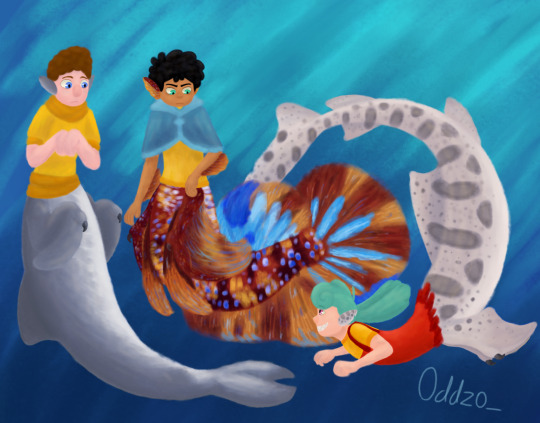
Max is a betta fish, Nikki is a leopard shark, and Neil is a harbor porpoise :D
(Let’s say that this is magical merperson water that both salt and fresh water creatures can live in)
This was supposed to be a silly low effort doodle but I found a new brush and chaos ensued
Because the creativity demons have taken me, I plan to hopefully draw the rest of the Camp Camp characters and maybe some others this month!
(Let’s see how long I last lmao)
Here’s the full list of the species everyone is:
Max- betta fish
Neil- harbor porpoise
Nikki- leopard shark
Harrison- mimic octopus (✨illusion✨)
Nerris- narwhal
Preston- koi (taisho sanke)
Space kid- harp seal
Nurf- Maine lobster (calico mutation)
Dolph- mudskipper (periophthalmus malaccensis)
Ered- yellow lipped sea krait (sea snake)
Jasper- ghost shrimp
David- North American river otter
Gwen- Galapagos sea lion
Quartermaster- electric eel (electrophorus varii)
Campbell- saltwater crocodile
CJ- marine iguana
Daniel- giant river otter
Pikeman- pacific spiny dogfish (sometimes called the piked dogfish lol)
Billy/snake- king snake eel (ophichthus rex)
Petrol- redtail catfish
Jermy- sargassum fish (frogfish)
Penelope Priss (garden mother/flower scouts leader)- zebra lionfish
Sasha- Randall’s pistol shrimp
Erin- dumbo ear guppy
Tabii- lined seahorse (yellow)
-
I have never spent so much time researching aquatic life, I’m going insane. Why can’t I ever get involved in things a normal amount.
(trick question, the answer is ✨neurodivergence✨)
#art#my art#camp camp#camp camp fanart#cc max#max camp camp#camp camp max#max cc#camp camp neil#cc neil#neil camp camp#neil cc#cc nikki#camp camp nikki#nikki camp camp#nikki cc#mermaid#merman#mermay 2024#merpeople#merfolk#digital art#illustration#mermay#camp camp merpeople
23 notes
·
View notes
Note
Hi! Not sure if you’re still active but I came across your mudskipper guide while setting up my tank and was wondering if you think silver barred mudskippers would get along with some bumblebee gobies or if they (mudskippers) would be too big for them?
Hello there! I'm not really active on this page like I was - though I still am online as @thenativetank and @fishcommunity so I see asks for this page as well.
Assuming we are talking about Periophthalmus argentilineatus, I think it's likely the mudskippers would eat the BBGs. While unlikely to get to 7.5 inches, they still would far exceed the size of the BBGs. If looking for Gobies, I'd try some mid sized species or Sleepers first - Knight Gobies are commonly available, but Candy Cane gobies might also be worth a shot. I'd avoid Dragon Gobies though, as their large size is likely to intimidate the mudskippers (unless you get them both at the same size).
I'd probably start out with Mollies just to test the waters, if you have at least 30 gallons of swimming space. They are chunky, not overly aggressive, and are inexpensive.
5 notes
·
View notes
Text
Diversity of Gobies (Actinopterygii, Gobiiformes) in the Rupnarayan River, West Bengal, India

Abstract
A total of 16 species under 13 genera in 4 families of Gobiiformes have been recorded from the Rupnarayan river. Of these Bostrychus sinensis is being reported for the first time from Indian mainland and Bathygobius ostreicola is being recorded for the first time from West Bengal. Four species viz., Acentrogobius viridipunctatus, Butis butis, Taenoides buchanani and Taenioides cirratus are being reported for the first time from Purba Medinipur district and 14 species viz., Acentrogobius viridipunctatus, Apocryptes bato, Bathygobius ostreicola, Boleophthalmus boddarti, Bostrychus sinensis, Butis butis, Butis koilomatodon, Eleotris fusca, Eleotris melanosoma, Odontamblyopus rubicundus, Periophthalmus modestus, Pseudapocryptes elongatus, Taenoides buchanani and Taenioides cirratus are being reported for the first time from Rupnarayan river. Periopthalmus weberi appears to have gone locally extinct in this River.

Introduction
Gobiiformes, the gobies and their relatives, is one of the world's most varied vertebrate lineages with over 2200 species distributed under more than 200 genera (Nelson et al., 2016). Gobies are found in tropical and subtropical waters, especially on coral reefs and estuaries and only 10% of which are found in freshwater (Helfman et al., 2009). Although some species are consumed by man mostly these are prey of economically valuable fish species. Some species are also valuable as ornamental fish (Patzner et al., 2012). Chatterjee and Mishra (2012) reported 174 gobioid species under 69 genera from India of which 45 species under 37 genera are found in Sundarbans of West Bengal (Chatterjee et al., 2013) and 23 species have been recorded so far from Purba Medinipur district (Jayram, 1981; Chatterjee et al., 2000; Yennawar et al., 2015, 2017; Payra et al., 2018; Hossain et al., 2019; Pahari et al., 2020; Khan and Mandal, 2024). Yennawar et al. (2017) and Chatterjee et al. (2000) recorded 14 and 9 species of gobies respectively from the coastal region of Digha, Purba Medinipur district, whereas, Payra et al. (2018) and Khan and Mandal (2024) each have reported 4 species of gobies from Egra and Ramnagar of this district. While Hossin et al. (2019) recorded Butis koilomatodon from Sankarpur, Sit et al. (2020) recorded Glossogobius giuris and Stigmatogobius sadanundio from Purba Medinipur district. River Rupnarayan, however, has remained rather unexplored in this regard. Gobiids recorded so far from this river are Periopthalmus weberi, G. guiris and S. sadanundio as reported by Jayram (1981), Ghorai (2018) and Pahari et al. (2020) respectively. Under such backdrop the present study on the diversity of order Gobiiformes of the Rupnarayan River, which constitutes the eastern border of Purba Medinipur district, was under taken.
Source : Diversity of Gobies (Actinopterygii, Gobiiformes) in the Rupnarayan River, West Bengal, India | InformativeBD
0 notes
Text
El pez de fango sobrevive mucho tiempo fuera del agua
El pez Periophthalmus, comúnmente conocido como pez saltarín del fango, es un pez con características extraordinarias e insólitas que lo distinguen de la mayoría de los peces. Este grupo de peces pertenece a la familia Gobiidae y está adaptado a vivir tanto en el agua como en tierra firme, lo que los hace realmente únicos en el mundo acuático. El Periophthalmus puede respirar tanto dentro como…
0 notes
Text
Periophthalmins, or mudskippers, are among the most unusual fishes to be traded as aquarium, or rather aquaterrarium novelties. Most of the species belong to the omnivorous to carnivorous genera, Periophthalmus and Periophthalmodon. More rarely traded is Boddart's blue spotted mudskipper, Boleophthalmus boddarti, which is a member of a more herbivorous genus commonly known as boggle eyed gobies or mudskippers, as well as blue spotted mudskippers. (For clarity all mudskippers comprise a closely related subset of the true gobies.) This Indo-West Pacific mudskipper grows to 22 centimeters long, or nearly reaches 9 inches. Its natural distribution according to collection records, spans from western India to Vietnam and Borneo. During low tide the large B. boddarti are present on unvegetated mudflats whilst the younger fish have a closer association with vegetation including mangrove pneumatophores. Some other mudskipper species are similarly distributed per size and age class in this way.
Mudskippers are true gobies that have adopted evolutionary tendencies to life right at and outside the waters edge. Of the mudskippers it is Periophthalmus itself that is best adapted to life out of water, skipping with agility upon, over and around mangroves roots and other such obstacles. Such is possible because of specializations to their physiology, senses, axial skeleton, pectoral finnage, and associated musculature. Boleophalmus have more restricted terrestrial abilities than Periophthalmus, and when their gills are compared to those of Periophthalmus and Periophthalmodon, they are of an unspecialised, plesiomorphic structure, and cannot hold and carry water. However the head and dorsal skin of Boleophthalmus is specialized to allow good gas transfer whilst the fish are emersed or near the water surface.
Boleophthalmus sp. are remarkable for their grazing specializations. To eat microscopic flora they place their lower jaw upon the mud, and move their heads side to side. As they do so, the horizontally positioned teeth on their lower jaw scrape the surface of the substrate. Contrasting against the strange dentition of the Boleophthalmus lower jaw, are the more normally vertical teeth that are present in their top jaw. The anatomy of their pharynx also shows specialization for its habit of feeding by sifting tiny items as. This derived mudskipper genus is an obligate grazer, and not in the least macropredatory. Diatoms are the dominant food items in the B. boddarti gut, but contrary to some sources claiming it is a strict diatom feeder, they comprise more than 1/2 of its diet throughout the year. Benthic green algae, fish eggs, nematodes, and annelids together form the rest of the diet of this mudskipper. Unsurprisingly Boleophthalmus harmlessly ingest a lot of fine substrate due to their strange feeding method. The curious oropharyngeal anatomy of herbivorous mudskippers, has been suggested to function at minimizing the ratio of inedible mud and sand particles to useful food biomass. Detritus is also proved to be ingested by these grazing mudskippers.
B. boddarti are very territorial animals, and striking threat displays and physical skirmishes occur between males occupying neighbouring burrows. When population density is high, B. bodderti construct mud ramparts around their own burrows. Cumulative building activities by numerous, neighboring fish is on a scale that alters the very landscape that they inhabit. The construction of walls creates pools of water and exposed mud slopes, from which diatoms are grazed by their builders. This species of mudskipper is thus considered to create farming ponds that guarantee its food supply. Males also display to attract females, who are then escorted to their burrows for the purposes of procreation. B. boddarti practice parental care, and their burrows serve them as safe nesting spaces.
Environmental reports from a typical B. boddarti habitat indicated a water pH of 6.8, and a salinity of 12 to 15 parts per thousand, or around 1.01 in terms of specific gravity. The water temperature reported was 31 to 33 degrees centigrade, whereas the temperature of the mud was 28 to 35 degrees. In the Mekong delta where B. boddarti is present, the water temperature was usually 28 to 29 degrees regardless of the wet and dry season, though the water salinity was lest constant, measuring as low as 3 ppt in the wet season and 9 ppt in the dry season. Therefore B. boddarti tolerates low end brackish specific gravities, of 1.002 to 1.007.
Experimentally this species tolerates a broader range of water salinities, from 4 to 27 ppt. One study of wild B. boddarti in eastern India, concluded that it tolerates a wider range of environmental variables, than do most of the partly sympatric mudskippers and similar gobies. Another study focusing on such species, along a much wider stretch of eastern India, demonstrates that B. boddarti forms a mudskipper community with Periophthalmus novemradiatus and P. variabilis, and Periophthalmodon schlosseri, as well as a fellow Boleophthalmus species, B. dussumieri. Although B. boddarti rarely arrives in the pet trade, it is one of the most successful of mudskipper species in the wild.
In the aquaterrarium, Boleophalmus require a fine, sloping substrate. At the deep end they should be able to submerge completely, but at the shallow end, they will be happy with their dorsum above the water surface. Despite reports that the natural diet of Boleophthalmus sp. is impossible to replicate in a captive setting, they will reportedly consume finely ground dried foods, such as fish flakes containing a high algal content. Powdered algae wafers containing animal protein would assumedly be ideal. Nonetheless imported specimens of Boleophthalmus tend to have a low survival rate, presumably because of improper treatment between the wild and tbe home aquaterrarium.
#Boleophthalmus boddarti#Boddarts blue spotted mudskipper#Boddarts goggle eyed goby#mudskippers#periophthalmins#aquaterrarium pets#brackish#misunderstood fish#amphibious fishes
0 notes
Text
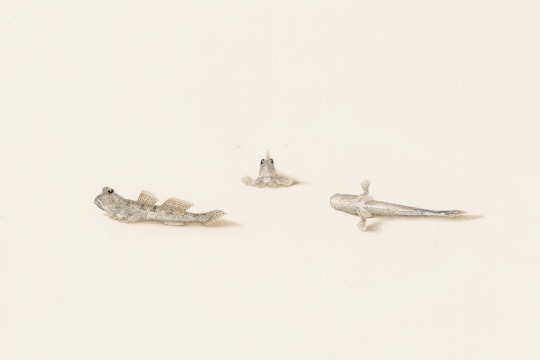
Mudskipper, Periophthalmus (1801) - Ferdinand Bauer
#Wonder Rooms#Cabinet of Curiosities#Public Domain#19th Century#Natural History#Scientific Illustration#Ferdinand Bauer#Zoology#Animalia#Fishes#Actinopterygii#Gobiiformes#Oxudercidae#Periophthalmus#Mudskipper
17 notes
·
View notes
Text
2021 Komedi Vahşi Doğa Fotoğrafları Ödülleri
2021 Komedi Vahşi Doğa Fotoğrafları Ödülleri
2021 Komedi Vahşi Doğa Fotoğrafları Ödülleri Bebek Samurları Yüzme Öğreniyor Deniz Altı Canlılar Kategorisi Birincisi: “Okul Zamanı” 2021 Komedi Vahşi Doğa Fotoğrafları Ödülleri Deniz Altı Canlılar Kategorisi birincisi seçilen bu fotoğrafta, anne susamurunun (Lutrinae Lutra) sabırla yavrusuna yüzme öğretiyor. Chee Kee Teo bu kareyi Singapur’da Kallang Nehri kıyısında yakalamış. Chee Kee Teo /…

View On WordPress
#2021#2021 Komedi Vahşi Doğa Fotoğrafları Ödülleri#ahşi Doğa Fotoğrafları#ahşi Doğa Fotoğrafları Ödülleri#Columba livia#Columba livia domestica#Cynomys#Haliaeetus leucocephalus#Komedi Vahşi Doğa Fotoğrafları Ödülleri#Lutrinae Lutra#Periophthalmus#Remove term: 2021 Komedi Vahşi Doğa Fotoğrafları Ödülleri 2021 Komedi Vahşi Doğa Fotoğrafları#Remove term: 2021 Komedi Vahşi Doğa Fotoğrafları Ödülleri 2021 Vahşi Doğa Fotoğrafları#Rhinopithecus roxellana
1 note
·
View note
Photo

86 notes
·
View notes
Photo

A bunch of mudskippers (Periophthalmus chrysospilos) "enjoying" the tide change all together in Borneo. These fishes live outside of water most of their time, thanks to the ability to keep their gills humid and breathing the oxygen in the air through their skin and oral mucosa (cutaneous air breathing). #fish #fishes #mudskippers #periophthalmus #chrysospilos #borneo #tide #sunset #malaysia #nikonphotography #nikon #tokina1017 #sea #seascape #outofwater #air #breath #wideanglelens #wildlife #marvelsofnature #predatoridelmicrocosmo
#predatoridelmicrocosmo#chrysospilos#breath#sunset#nikonphotography#seascape#malaysia#tide#nikon#sea#mudskippers#outofwater#marvelsofnature#fishes#tokina1017#borneo#wideanglelens#periophthalmus#wildlife#air#fish
2 notes
·
View notes
Photo
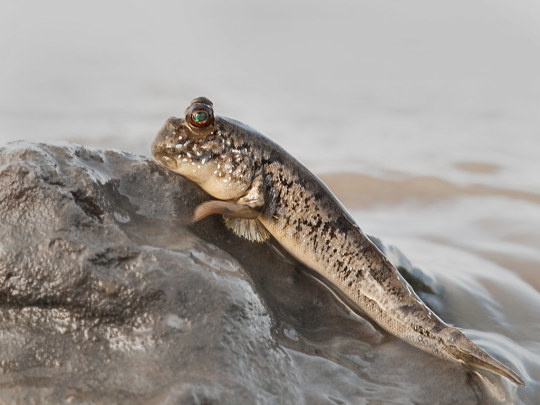

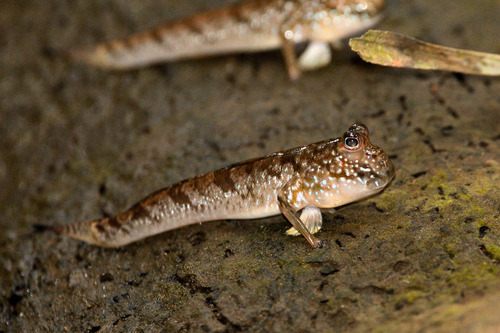
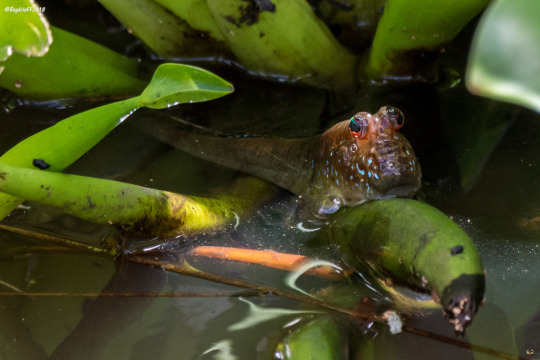
The Atlantic Mudskipper: A Fish Out of Water
Found only along the west African Cost, the Atlantic Mudskipper (Periophthalmus barbarus) is an incredibly unique species of fish. What makes it so special is that, unlike most other fish, the mudskipper can survive on land. It has several adaptations to make it semi-terrestrial. A layer of mucus over the surface of the body allows it to retain moisture, and when on land it can close its gill chambers and breathe through its skin. The eyes are set high on the head and can move independently 360 degrees, giving the Atlantic mudskipper a wide range of vision. Lastly, the pectoral fins that allow it to crawl, climb, and even skip on land, aided by a pair of pelvic fins.
P. Barbarus’ special adaptations allow it to occupy uncommon habitats within its range. It prefers semi-salty brackish water, especially at the mouths of rivers and in mudflats, although they are able to tolerate a range of temperatures and salinity. They can also be found in mangrove forests and lagoons, where they can climb up onto the roots of trees. Along the coast, individuals are most often visible at low tide when they climb up on the shore to feed. In these regions the Atlantic mudskipper digs burrows in which they can hide during high tide. To blend in, they are usually tan to dark brown with dark mottling along the back and bright blue spots on the cheeks.
During the day, the Atlantic mudskipper spends most of its time feeding and defending its territory. They are carnivorous fish, preying on crustaceans, insects, and small fish. The mouth of P. barbarbus is specially shaped so that it covers its prey with water, then sucks the water back up with its accompanying meal. When threatened by terrestrial predators such as shore birds, the Atlantic mudskipper lives up to its name and will ‘skip’ away. These fish also use their mouths in fights, which are quite common. Individuals typically guard of about 1m around their burrow. Males are especially territorial, and will fiercely guard burrows and mates from competitors. Despite their ferocity, Atlantic mudskippers are not very large; most only grow to be 14-16cm long.
Mating occurs year round, although peak times are between February and May. Males engage in territorial displays, after which females will select a male and enter his burrow to lay eggs. Clutches can easily number in the thousands, although few survive to adulthood. The male guards the burrow and, after a brief incubation period, floods it to induce hatching. Larvae drift for 1-2 months before metamorphosing into a juvenile stage, at which time they begin to return to land. Individuals reach sexual maturity at about 10.2-10.8 cm in length, roughly 1 year after hatching, and can live up to 5 years in the wild.
Conservation status: The IUCN rates the Atlantic mudskipper as Least Concern, although populations are declining. Their primary threats are from over-fishing and by-catch, pollution, and urban development. Some areas within their region have instituted sustainable fishing practices and established protected reserves as part of conservation efforts for this species.
Photos
Eva Mártensson
Eric Verhagen
Pedro Martins (via iNaturalist)
Rogerio Ferriera
#atlantic mudskipper#Gobiiformes#Oxudercidae#mudskippers#gobies#fish#Ray-Finned Fish#bony fish#wetlands#wetland fish#rivers#river fish#intertidal fauna#intertidal fish#coral reefs#coral reef fish#atlantic ocean#africa#west africa#animal facts#biology#zoology
150 notes
·
View notes
Note
mudskipper.....
love these guys!!

Atlantic mudskipper | Periophthalmus barbarus

Barred mudskipper | Periophthalmus argentilineatus

Slender mudskipper | Periophthalmus gracilis

Blue-spotted mudskipper | Boleophthalmus boddarti
Photo credit: x, x, x, x
133 notes
·
View notes
Link
1 note
·
View note
Photo

Afrikanischer oder Atlantischer Schlammspringer | Atlantic mudskipper
Periophthalmus barbarus
[Hagenbecks Tropen-Aquarium]
#AfrikanischerSchlammspringer#AtlantischerSchlammspringer#Atlanticmudskipper#Periophthalmusbarbarus#Schlammspringer#Mudskipper#HagenbecksTropenAquarium#Hagenbeck#Hamburg
3 notes
·
View notes
Photo

#Periophthalmus takita#Mudskipper#animals#world#Chordata#Actinopterygii#Perciformes#Gobiidae#Oxudercinae
2 notes
·
View notes
Photo

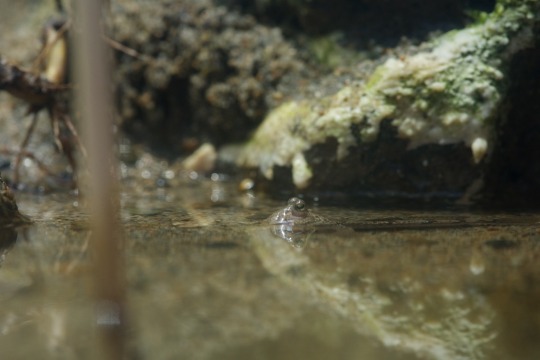


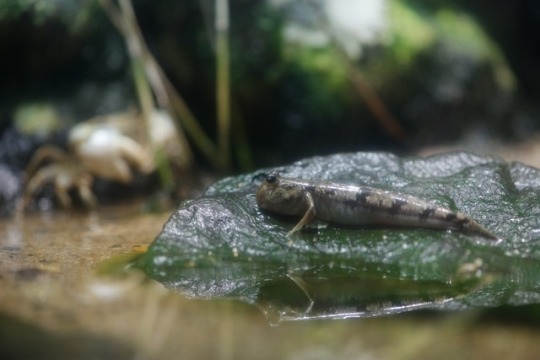

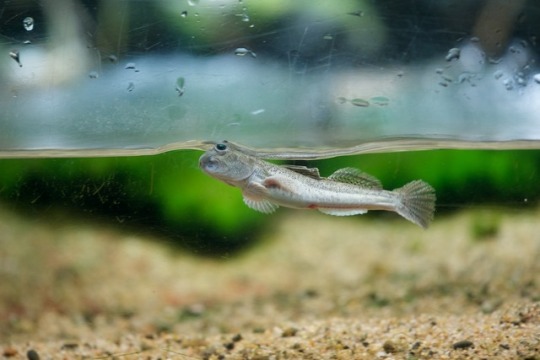

トビハゼ 学名:Periophthalmus modestus 分類:スズキ目 ハゼ科 分布:東京湾から種子島の太平洋沿岸、瀬戸内海、有明海、沖縄、朝鮮半島ほか
[memo(アクア・トトの解説より引用)] 泥の表面にすむゴカイやカニのほか、アリなどの陸生の昆虫も食べます。冬は地面に掘った巣穴の中で過ごします。
トビハゼの呼吸 トビハゼの仲間は、胸ビレを腕のように使って泥の上をはい回り、時には尾を使ってジャンプをします。潮が満ちてくると、。水をさけるようにして石の上などに移動します。このように長い時間を陸上ですごすことができるのは、皮フの表面近くに毛細血管の発達した部分があり、そこで皮フ呼吸をするからです。皮フが乾燥しないように、時々、泥の上で寝転がり体をしめらせています。また、大きくふくらませたエラぶた内に水をためて、その水を使って、陸上でエラ呼吸もすることができます。
アクア・トトぎふ 3F 長良川中流から河口
10 notes
·
View notes